

6 Blended Learning Models: When Blended Learning Is What’s Up For Successful Students. Technology Tools for Teachers - EdTechTeacher. Every year, so many new technology tools for teachers are launched into the market that it can be nearly impossible to keep up with them all. In order to keep you up-to-date with the latest and greatest educational tech tools, our team of edtech specialists has put together this list of the best edtech resources and technology tools for teachers. Clicking on the links below will take you to hundreds of apps, websites, extensions, and more.
Whether you're looking for a specific tech tool or just trying to find something new and interesting for your class, we encourage you to browse around all of the different categories to see how many wonderful resources are available for your students. Also, if you have a tool that you'd like to see added to the list, please feel free to contact us at admin@edtechteacher.org. The following technology tools for teachers have been organized by academic subjects, topics, and learning activity. CertICT. MyWordbook 2. And ... action! Mobile learning in the classroom. In our latest guest post, inspired by her Innovate ELT talk, Kat Robb tells us about using video and mobiles in her classes.
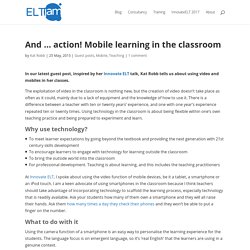
The exploitation of video in the classroom is nothing new, but the creation of video doesn’t take place as often as it could, mainly due to a lack of equipment and the knowledge of how to use it. There is a difference between a teacher with ten or twenty years’ experience, and one with one year’s experience repeated ten or twenty times. Using technology in the classroom is about being flexible within one’s own teaching practice and being prepared to experiment and learn.
Why use technology? To meet learner expectations by going beyond the textbook and providing the next generation with 21st century skills developmentTo encourage learners to engage with technology for learning outside the classroomTo bring the outside world into the classroomFor professional development. #IATEFL 2016 - Forum on Mobile Learning.
Having reviewed the forum on technology in the young learner classroom already, I have decided to stick with the "3-in-1" talk format with some thoughts and reflections on the forum on mobile learning.
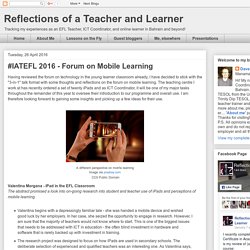
The teaching centre I work at has recently ordered a set of twenty iPads and as ICT Coordinator, it will be one of my major tasks throughout the remainder of this year to oversee their introduction to our programme and overall use. I am therefore looking forward to gaining some insights and picking up a few ideas for their use.Valentina Morgana - iPad in the EFL ClassroomThe abstract promised a look into on-going research into student and teacher use of iPads and perceptions of mobile learning.
Valentina begins with a depressingly familiar tale - she was handed a mobile device and wished good luck by her employers. In her case, she seized the opportunity to engage in research. However, I am sure that the majority of teachers would not know where to start. A beginner's guide to mobile learning in ELT. Nicky Hockly: Going Mobile_58. The International Research Foundation for English Language Education. Video Greeting from TIRF Trustee Michael Carrier The use of mobile and handheld technology is growing exponentially in language education, and it is clear that much more research, project evaluation, and evidence-based analysis are needed to help us understand this new phenomenon.

However, important questions remain about the efficacy of handheld devices in language learning. What benefits do learners, teachers and school administrators derive from the use of mobile and handheld technology? What are the challenges and pitfalls? Can this technology be misapplied and waste precious resources? With questions like these in mind, TIRF has commissioned six papers to explore the current state of mobile-assisted language learning (MALL). The following provides brief information about the five papers and the authors who wrote them. Beyond the Classroom: Mobile Learning the Wider World. Is The Flipped Classroom Relevant to ELT? Is The Flipped Classroom Relevant to ELT?
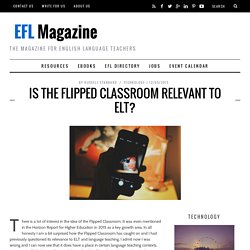
There is a lot of interest in the idea of the Flipped Classroom. It was even mentioned in the Horizon Report for Higher Education in 2015 as a key growth area. 3 keys to a flipped classroom. If you are planning to use the ‘flipped classroom’, then you might want to think about a few key ideas.

Background: On Connected Principals Jonathan Martin has written a couple posts on the Flipped Classroom. In his first one, Reverse Instruction: Dan Pink and Karl’s “Fisch Flip”, he says: Increasingly, education’s value-add is and will be in the coaching and troubleshooting when students are applying their learning, and in challenging students to apply their thinking to hands-on learning by doing and teaming: so let’s have them do these things in class, not sit and listen. And in his second post, Advancing the Flip: Developments in Reverse Instruction, he says: Flip your instruction so that students watch and listen to your lectures… for homework, and then use your precious class-time for what previously, often, was done in homework: tackling difficult problems, working in groups, researching, collaborating, crafting and creating.
And also contrary to my points below… Dr. 1. 2. 3. Dr. The Flipped Classroom in ELT. Flipped learning – or the flipped classroom – is one of the hot topics in education at the moment.
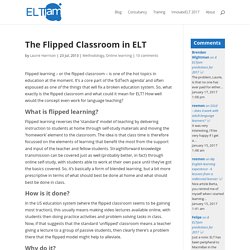
It’s a core part of the ‘EdTech agenda’ and often espoused as one of the things that will fix a broken education system. So, what exactly is the flipped classroom and what could it mean for ELT? How well would the concept even work for language teaching? Why I Gave Up Flipped Instruction. A little over a year ago I wrote a post about the flipped classroom, why I loved it, and how I used it.
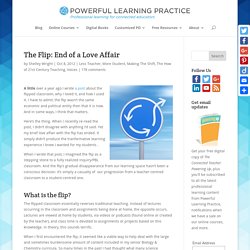
I have to admit, the flip wasn’t the same economic and political entity then that it is now. And in some ways, I think that matters. Here’s the thing. When I recently re-read the post, I didn’t disagree with anything I’d said. Yet my brief love affair with the flip has ended. A Comprehensive List of Apps and Tools to Flip your Classroom. For those of you intent on employing the flipped learning model in their instruction, we have curated a set of important web tools to help you create the appropriate flipped classroom environment for your students.
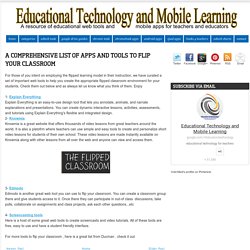
Check them out below and as always let us know what you think of them. Enjoy 1- Explain Everything Explain Everything is an easy-to-use design tool that lets you annotate, animate, and narrate explanations and presentations. You can create dynamic interactive lessons, activities, assessments, and tutorials using Explain Everything's flexible and integrated design. 2- Knowmia Knowmia is a great website that offers thousands of video lessons from great teachers around the world. Common Craft Explains Blended Learning. Disclosure: I have an in-kind business relationship with Common Craft.

Common Craft's latest production explains blended learning in under three minutes. In the video, embedded below, teachers who are unfamiliar with the term blended learning can learn a basic definition of blended learning, the role of Learning Management Systems (LMSs) in blended learning, and the potential benefits of blended learning.
While Edmodo and Google Classroom get most of the attention these days a new LMS that is worth checking out is Otus. Blended Learning in Different Models That Work. Technology Tools for Teachers. Every year, so many new technology tools for teachers are launched into the market that it can be nearly impossible to keep up with them all.

In order to keep you up-to-date with the latest and greatest educational tech tools, our team of edtech specialists has put together this list of the best edtech resources and technology tools for teachers. Clicking on the links below will take you to hundreds of apps, websites, extensions, and more. Whether you're looking for a specific tech tool or just trying to find something new and interesting for your class, we encourage you to browse around all of the different categories to see how many wonderful resources are available for your students. Also, if you have a tool that you'd like to see added to the list, please feel free to contact us at admin@edtechteacher.org. Learning Management Systems: The wrong place to start elearning.
Learning Management Systems: The wrong place to start learning November 22, 2004 George Siemens Learning Management Systems (LMS) are often viewed as being the starting point (or critical component) of any elearning or blended learning program. This perspective is valid from a management and control standpoint, but antithetical to the way in which most people learn today. Reclaiming Innovation. Today, innovation is increasingly conflated with hype, disruption for disruption's sake, and outsourcing laced with a dose of austerity-driven downsizing.
If any concept should be seen as an uncomplicated good thing in higher education, it's innovation. Defined by a common-sense notion of "doing things better" and burnished by the sheen of dazzling technological advances, what's not to like about innovation? Yet as 2014 churns on, the glow is wearing off. Today, innovation is increasingly conflated with hype, disruption for disruption's sake, and outsourcing laced with a dose of austerity-driven downsizing. Call it innovation fatigue. How did we get here? To understand much of the disconnect between higher education and innovation, we should take a look at innovation's unruly cousin: disruption. Will a countervailing vision of grassroots, generative innovation dedicated to strengthening higher education do better? Where are we today, two decades later? Argument #2 Systems. Silos. Costs. Features. Moodle is a free, online Learning Management system enabling educators to create their own private website filled with dynamic courses that extend learning, any time, anywhere.
Whether you're a teacher, student or administrator, Moodle can meet your needs. Moodle’s extremely customisable core comes with many standard features. What is Blackboard. Connect With Students and Parents in Your Paperless Classroom. Learning Management System. GoClass - Redefining Classroom. K-12 Digital Learning Platform. Create & Find Free Multimedia Lessons. Classroom Help. Sakai. Learning Management System.